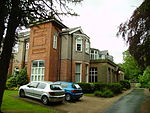Church of St Wilfrid, Northenden
Church of England church buildings in Greater ManchesterChurches in ManchesterGrade II* listed churches in Manchester

The Church of St Wilfrid is an Anglican church in the suburb of Northenden in Manchester, England. It stands on Ford Lane, close to the River Mersey, approximately 8 kilometres (5.0 mi) south of Manchester city centre. The church is late medieval in origin and was substantially re-built in the 19th century by the Gothic Revival architect J. S. Crowther. The church was designated a Grade II* listed building on 25 February 1952.
Excerpt from the Wikipedia article Church of St Wilfrid, Northenden (License: CC BY-SA 3.0, Authors, Images).Church of St Wilfrid, Northenden
Ford Lane, Manchester Northenden
Geographical coordinates (GPS) Address External links Nearby Places Show on map
Geographical coordinates (GPS)
| Latitude | Longitude |
|---|---|
| N 53.4071 ° | E -2.2535 ° |
Address
St Wilfrid
Ford Lane
M22 4NQ Manchester, Northenden
England, United Kingdom
Open on Google Maps





